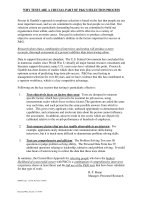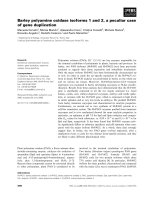Chapter 2: A Versatile Frame of Mind docx
Bạn đang xem bản rút gọn của tài liệu. Xem và tải ngay bản đầy đủ của tài liệu tại đây (167.12 KB, 15 trang )
Chapter 2
A Versatile Frame of Mind
Outline
Approaches to Negotiation
•
Distributive negotiation
•
Integrative negotiation
Dangers of Assumptions
•
Importance of sensemaking
•
Identifying rules of engagement
Use of Questions
Awareness of the Environment
Importance of Language
Identifying “Moves” of Interaction
Negotiation Continuum
Dis tributive
Ne gotiatio ns
Integrative
Ne gotiatio ns
Ve rs atile
Ne gotiatio ns
Des ire to WIN
Achieve
Mutual Gain
Which approach is best?
Those using cooperative strategies
achieve high mutual gain
Those relying on competitive strategies
achieve less
Thus, negotiators should focus mainly
on establishing cooperation
Which approach is best?
Negotiators who believe they have influence,
assume a position of strength and hold firm
on issues of importance
Those who believe they have little influence
are more likely to make greater concessions
Thus, a cooperative, win-win approach is
generally useful but a negotiator must also
identify how much they are willing to
concede in order to achieve the win-win
The Versatile Negotiator
Adopt a flexible negotiating approach – moving
toward an integrative or distributive stance when
necessary
Prioritizes goals in order to protect the most
important points but make appropriate concessions
Not committed to a win-win or win-lose
Win-win is preferable but sometimes will engage in a
win-lose in order to achieve goals
Does not measure their progress in comparison to
some endpoint but stay focused in their next move
and how it will affect each subsequent move
Avoid Assumptions
Be careful in making faulty assumptions
•
Myth of commonality
•
We assume people are like us
•
Myth of disparity
•
We assume others are different from us
Skilled negotiator is a detective –
skeptical of easy generalizations & alert
to limitations of assumptions
Sensemaking
Balance between observation and
action
Staying in touch with context
Sensemakers “act their way into an
understanding of where they are, who
they are and what they are doing.”
Rules of Engagement
Knowledge of one’s expectations
guiding choices
Negotiations make sense when the
dialogue is bounded by what is
expected
Failure to meet expectations may lead
to perceptions of irrelevance or
offensiveness
Identifying Expectations
Use of Questions
•
Critical in identifying assumptions &
expectations
•
Assist in ensuring understanding – possible
discrepancy between what was said and
what was heard
•
Useful in testing the progression of
negotiations
•
Involves the other party more in the
discussion
SPIN Questioning
SITUATION
PROBLEM
IMPLICATION
NEED
What
supplier
are you
currently
using?
What
supplier
are you
currently
using?
How satisfied have you
been with your
supplier’s ability to
meet your needs for
“emergency shipments?
How satisfied have you
been with your
supplier’s ability to
meet your needs for
“emergency shipments?
How have you been
affected by their
inability to meet your
emergency inventory
levels?
How have you been
affected by their
inability to meet your
emergency inventory
levels?
If we guaranteed next day delivery
on specific products, would you be
interested in learning more about
our capabilities?
If we guaranteed next day delivery
on specific products, would you be
interested in learning more about
our capabilities?
Adapted from SPIN Selling by Neil Rackham
Negotiation as a Learning Process
Importance of a learning perspective
Enables negotiator to understand the
other party
Versatility in Actions
Repertoire of verbal and non-verbal
responses
Communication in negotiations like a
game of chess
•
More skillful players influence the other
player to make a desired move
•
Amateurs are easily led and react to the
moves of others – leading to greater
chances for concessions
Knowledge of scripts
Direction of Interaction
One-up moves
•
When both use one-up statements, the
interaction is competitive
One-down moves
•
When both use one-down statements, very
little progression is achieved
Sidestep moves or one-across moves
•
Useful in negotiations because they buy
you time and give you a chance to think
about how to proceed (e.g. silence, I see)
Summary
Best negotiators less concerned with
who’s right
But…concerned about who thinks what
and why
They mold perception and are masters
of discernment
Do not use firm statements of positions
but questions designed to understand
assumptions









